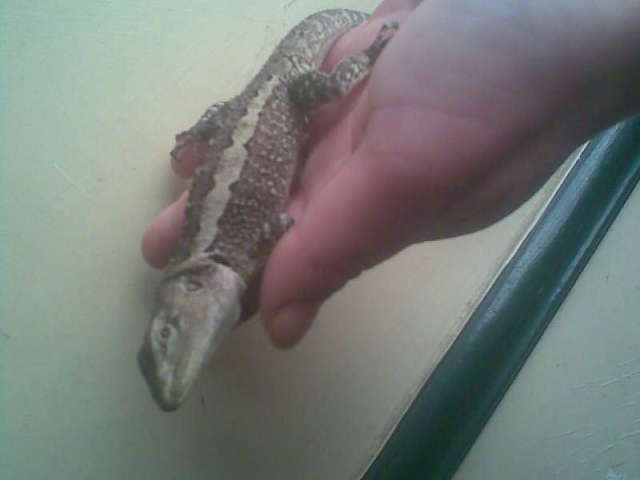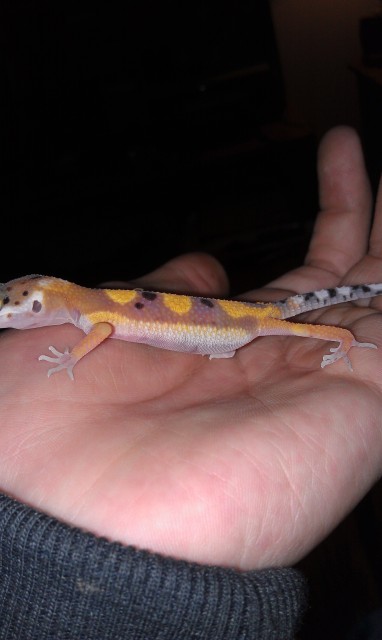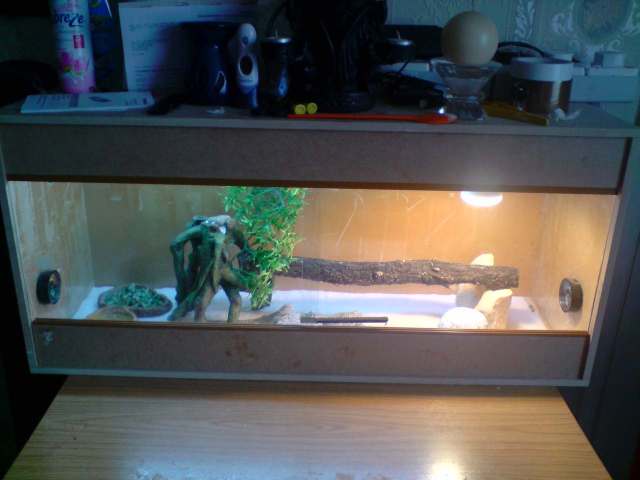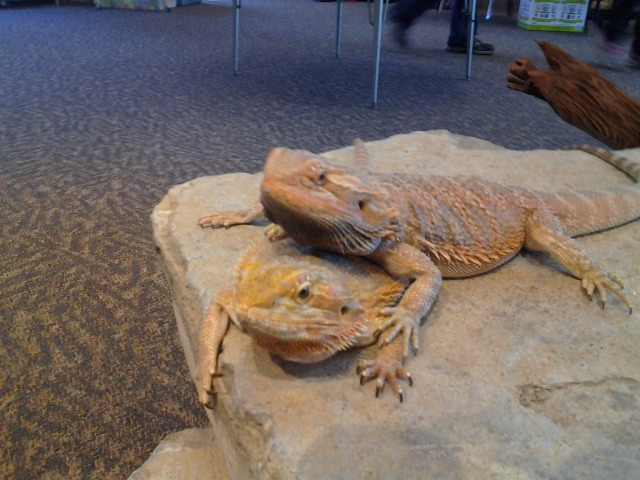QuestionThank you so much for your speedy reply! It seems as though every book we read along with every website we looked at AND every person working in a pet store that seemed to know about BD's-the information we gathered all clashed. The reason why I wanted to feed him the greens.fruits I mentioned were because I read from MULTIPLE sources that it was ok. I hate receiving false information and feel terrible that I have put his health in jeopardy because of reading false information-even from published books!
What wattage heat lamps do you suggest. The digital thermometer said the bottom of the cage is mid 80's and the top is 90-92. Thanks.
-------------------------
Followup To
Question -
Last night my beardie's hind legs began twitching-like muscle spasms. His hind leg's toes were also twitching. He is approx. 4-5 months old. Mainly eats small crickets and meal worms. My boyfriend has had him this whole time and hasn't been giving him greens/fruit (kale, broccoli, kiwi and orange) like I started him out eating (along with the crickets). Also, he hasn't been sprinkling food with the calcium we bought and hadn't set up the UV light on top of the cage. There is just the red heat lamp.
I confiscated "Santana" last night and bought the food listed above, although there were no crickets left and all the pet stores were closed by that time. I put a call into the vet, but wont be able to speak to the Reptile specialist until noon-ish.
His legs stop twitching when I take him out of his cage, and he ate some fruit and kale last night with the calcium and without the calcium. I looked at him this morning and he was sitting on a tree we bought him (its tall and he loves sitting on it to be closer to the heat lamp)and both of his hind legs were stretched out far behind him twitching. I took him out and he walked around on my bed like he was fine. Maybe he also has a problem with the tree/cage? The cage we have for him is no big but its tall with a rock climbing feature along the back wall. We have a regular aquarium but thought we liked this more. Also the tree, he never comes out of it. He waits until we take him out of the cage to have a bowel movement. The tree might be the problem as well. PLEASE ADVISE!!!!!! Thank you for your time. Sincerely, Jenifer Starr
Answer -
Hi Jennifer,
Its great that you have taken over the care of the dragon!! Now we can get him on the right track with great care!! Its great you have a call into the vet...The vet may prescribe a prescription calcium supplement for you to use.
It sounds like your dragon may be showing signs of metabolic bone disease (twitching)which is caused by a calcium deficiency ..due to not having the correct uvb lighting. Without the correct uvb lighting, the BD/s cannot process the calcium that is in the foods they eat. The foods you listed (kale, broccoli, kiwi and orange) really are not good foods for a BD. The kale and broccoli are high in goitrogens which interfere with iodine absorption, which leads to thyroid problems. Kiwi and Oranges are high in acids which most reptiles do not do well with. Better foods to feed are listed in the caresheet below, along with more info on the uvb and other care.
You don't mention how big the cage is but I recommend not having something very tall for your dragon to climb on...they aren't known to be arboreal(living in trees)so low branches are much better. Usually a branch or shelf that puts the dragon 6-8 inches under the uvb tube light is best. Branches should be at least 1.5 times as wide as the dragon so that they have room to lay on it and turn around.
Getting him on the right diet with the information below (greens, gut loaded and dusted insects) will get him back on the right track health wise. As I said, its wonderful you have the call into the vet and getting him checked out by the vet is needed. With him staying in the tree, close to the heat lamp it can mean that he isn't getting warmed up as he should. Double check your temperatures using the info below as a guide.
If you have any more questions or don't understand something, please be sure to ask. Please let me know how it goes with the vet and again, thank your for taking the bearded into your care.
BASIC BEARDED DRAGON CARE:
HOUSING:
For an adult bearded Dragon, a 50 -55 gallon is the smallest recommended tank. For a baby, nothing less than a 30 gallon tank will work for a very short time, so its best to just start out with the adult sized tank....you can add rocks and branches for climbing, being sure to not stack rocks too high to prevent them toppling over. Branches need to be secure. All items brought from outside need to be cleaned well before placing them in the BD's tank. To clean them, there are a few methods: to wash in a bleach solution of 1/4 cup of bleach to 1 gallon of water. Let them soak for about an hour, rinse them in hot water several times and then let them dry in the sun until completely dry. If the items are small enough, they can be baked in an over at 200 degrees for about 2 hours, check often to be sure they are not starting to burn. The items can also be boiled(simmered) for 30 minutes or so and then allowed to dry completely before placing in the tank. I also suggest washing any pet store items such as caves, rocks, branches, etc before placing in the tank as that if the store would happen to have mites they can also be on the items we purchase. Any of the above methods are acceptable for cleaning. CAUTION!!! On store bought branches...be VERY careful with the driftwood pieces that have the holes in them!!! Be sure the holes are small as that if the holes are large, the BD MAY be able to get his head in them but not able to get it back out!!! A secure screen top is necessary for bearded dragons as that also they do not require much height for climbing..they can and do climb!! NEVER USE HEAT ROCKS OR HEATED CAVES!!! They malfunction and cause severe burns and even death!!!!
SUBSTRATES:
Young bearded dragons MUST be kept on paper towels, newspaper or other non particulate(loose) substrate to prevent them from getting any loose substrate into their mouth and swallowing it which can and does cause intestinal blockages.Once the BD is over 10 inches, some people have had good luck using play sand mixed with 50% of peat moss. I prefer the safe substrate of the newspaper, or other non particulate substrate to prevent any problems and also for ease of cleaning.
LIGHTING:
BD's need UVB, which is the special lights
that come in fluorescent tubes or special screw in bulbs
(mercury vapor)that are designed to produce uvb and heat.
The tubes do not produce heat. UVB is needed by the BD
to be able to absorb the calcium in the foods they eat.
With out the uvb, they will develop metabolic bone disease.
With the tubes, they must say that they produce BOTH uvb and
uva. The uvb needs to be 5% or higher. Repti Sun 5.0 are
one of the best uvb tubes on the market. The repti glo 8.0's are testing out to be a great uvb source also. Arcadia 5.0 (UK), which is the uvb tube available in the UK is a good uvb tube.
These need to be positioned 6-8 inches over the BD so
that they get the uvb that is needed. Recommended length of the tube is 24 inches or more. They need to be replaced every 6-9 months as that they stop producing uvb long before they stop producing light. They need to have access to uvb and basking temperatures for 10-12 hours daily. At night, no white lights!!!
There are tubes and bulbs
that say ''full spectrum'' but they do not produce any uvb.
On the mercury vapor , they also produce heat. They also
produce the uvb and uva. The best on the market now are the
MEGA RAY or the T-Rex. www.reptileuv.com has more information on the Mega Ray lights. When using these, the distance is much greater
than the uvb tubes and the directions must be followed that
are listed for the light. When using the mercury vapor
lights, you don't need to have one light for uvb and one for
heat. The Mercury vapor lights provide both.
HEATING AND TEMPERATURES:
Bearded Dragons have specific temperature requirements. For heat when using the uvb producing fluorescent tubes, a regular household lightbulb will work for DAYTIME heat. The wattage needed will vary to each situation such as tank size, room temperatures, air flow. Their basking area temperature must be between 95F and 105F degrees to allow proper digestion of food. Your basking area must be where the uvb light is as well as the heat source. Be sure that the BD cannot get too close to the heat source as that they WILL get burned! The ambient temperature range in the mid 80's . Cool daytime range of normal room temperature of low to mid 70's. Nighttime temperatures in the low to mid 60's is fine. NEVER USE HEAT ROCKS!!!!!!!!!!!!!!!!!!!!! A good digital thermometer is a must. I like using the duel ones with the probe...cost about 15$ at Wal Mart. The probe can be placed in the basking area at the BD's level to monitor this temperature and the main unit can be placed in one of the ambient temperature areas. When reading them, the "out" reading is the probe area.
DIET:
Bearded Dragons eat and need both animal proteins and vegetable matter!!! As young dragons they eat a bit more of the insects. As they get older, as adults their diet is more of the vegetable matter. As young BDs, the diet is about 80% animal proteins and 20% vegetable matter. As they get older, the ratio changes. An adult will eat about 80%-90% vegetable matter and 10-20% animal proteins.
Animal protein sources are: Crickets, superworms, silkworms, roaches, hornworms, waxworms. Waxworms are considered candy to a BD so only feed on occasion in a small amount(2-3 worms). ALL insects must be properly gutloaded for at least 48 hours prior to feeding to the dragon. For crickets and superworms, this can be done with vegetables, plain cereals and commercial foods for the species. Silkworms and the other insects have their own diet needs. Its best to feed the crickets in a seperate feeding tank such as a 10 or 20 gallon size tank or container with a well vented lid. This can make it easier for the dragon to catch the crickets and prevents any stray crickets in their "home" tank from deciding to nibble on the BD if he happens to not find them all. If you do feed in his home tank, be sure to place a 1/2 potato in the tank to help prevent the crickets from biting at the BD.
ALL insects fed must be no larger than the space between their eyes to prevent choking. Be sure to dust the insects daily(for dragons up to 14-15 inches) (2x wkly there after)with a good calcium source such as Rep Cal calcium powder with no added Phosphorus. For dragons up to Young BD's up to 4 months of age will eat more crickets than anything. At this age they will usually consume anywhere from 10 to 30+ correctly sized crickets three times a day. Be sure to remove any uneaten crickets that are not consumed in a 15-25 minute time frame. For this reason, its easier to use a separate feeding tank for the bearded dragon. A 10 gallon tank(with a screen top) works well. Its best to offer their "salad" of greens/veggies before offering their morning insect feeding when they are hungry to prevent any problems with them preferring NOT to eat their salad. Their salad consists of Collard greens, mustard greens, turnip greens, dandelion greens...... this is the BASE of the green part of their vegetable diet. To this, for variety you can add arugula, escarole, endive,small amounts of bok choy or other Asian greens. For the vegetable part of the diet, green beans, butternut squash, acorn squash(other winter squashes are also acceptable) yams, sweet potato. For color, sweet peppers can also be added in a small amount. For baby BD's, using a food processor for the greens and veggies works well. As they get older, greens should never be larger than about an inch x an inch in size. Never feed lettuces as they have no nutritional value. The hard veggies should be either food processed or grated. Fruits can also be offered in small amounts. Good fruits are figs, papaya, melon, blueberries, strawberries, raspberries....and many other fruits... these need to be mashed or chopped. Watermelon is a good source of water for the dragon. Their salad can be dusted once or at the most, twice a month with a good vitamin supplement such as RepCal HerptiVit. This is by no means a complete list of foods the dragons!
can eat
. You can also offer baby food chicken or small bits of boiled chicken.
!!!
Be sure to provide a dish of FRESH drinking water at ALL times!!! Misting their salad will also help get much needed water into them. NEVER FEED any MICE or other mammals to your Dragon!!!
WATER:
As stated above, always provide a dish of drinking water and mist their salad. You can also bathe your dragon a few times a week. Temperature of the water should be between 85 and 95 degrees. The depth should never be any deeper than to cover his back when laying FLAT!!! Never leave them unattended at bath time to prevent possible drowning. Many love to soak and swim for 15 minutes or more. Never bathe less than two hours before his basking lights go out. Doing so can cause him to become too chilled, risking the chance of a respiratory
infection.
A vet check up is recommended and a fecal sample taken in to be tested for any internal parasites.... To find a qualified vet in your area you can go to http://www.anapsid.org/vets/
More in-depth care info can be found at: http://www.biology.lsa.umich.edu/research/labs/ktosney/file/BDcare.html
http://www.sundialreptile.com/care%20sheet--bearded%20dragon.htm
AnswerWhen there are any health problems, its best to stick to the "top shelf" greens and fruits. The reason is, its better to fill them up on the good nutritional greens than it is to fill them up on the filler greens that have little or no correct nutritional values.
Feeding a small amount of kale in a mix of the other suggested greens is ok.... kiwi, on occasion is also ok...but there are so many other good fruits to feed such as papaya(which is very high in calcium) and figs..again, very high in calcium. Watermelon is a good choice as that it is high in water. I would stay away from the broccoli and oranges though.
Its not your fault that you receive out dated or incorrect info. Most pet stores go with the info they found 10 years ago, or they just take guesses at the care. Books, which were published 5 yrs ago are actually outdated in much info. I tend to trust the people that are constantly researching and updating their information such as on the links I gave you. On the temperatures, you need to get your basking temps up to the recommended temps. They need these temps to properly digest their foods. This is the area that is directly under the heat source, and also the uvb is provided in this area. Looks like you have the ambient temps where they need to be..that's great!!! If you are using special uvb producing fluorescent tubes, you can use regular household light bulbs for daytime heat. The wattage needed will depend on the size of the tank, room temperatures and, what is needed to get the temperature range of 95-105 in the basking area. Generally, this can be accomplished with a 60 -100 watt light bulb, but as I said, you need to base it on what is needed to get the correct basking temperatures. When measuring the basking temperatures be sure to measure them at the exact level where the dragon lays...right on his shelf or branch. If you need more of an explaination on this, give a shout!!

 new striped water dragon.?
QuestionQUESTION: i got ur reply about the parasites an
new striped water dragon.?
QuestionQUESTION: i got ur reply about the parasites an
 Vomiting Leopard Gecko
QuestionBloating and Tail
QUESTION: Hi Tracie,
T
Vomiting Leopard Gecko
QuestionBloating and Tail
QUESTION: Hi Tracie,
T
 10wk beardie
QuestionQUESTION: hi diane,
here are the other links of
10wk beardie
QuestionQUESTION: hi diane,
here are the other links of
 bearded dragon breeding
Question
Delylah and Spike
I have a 4 year old f
bearded dragon breeding
Question
Delylah and Spike
I have a 4 year old f
 Juvenile Green Crested lIzard
QuestionQUESTION: Hi, I just got a wild caught green cr
Juvenile Green Crested lIzard
QuestionQUESTION: Hi, I just got a wild caught green cr